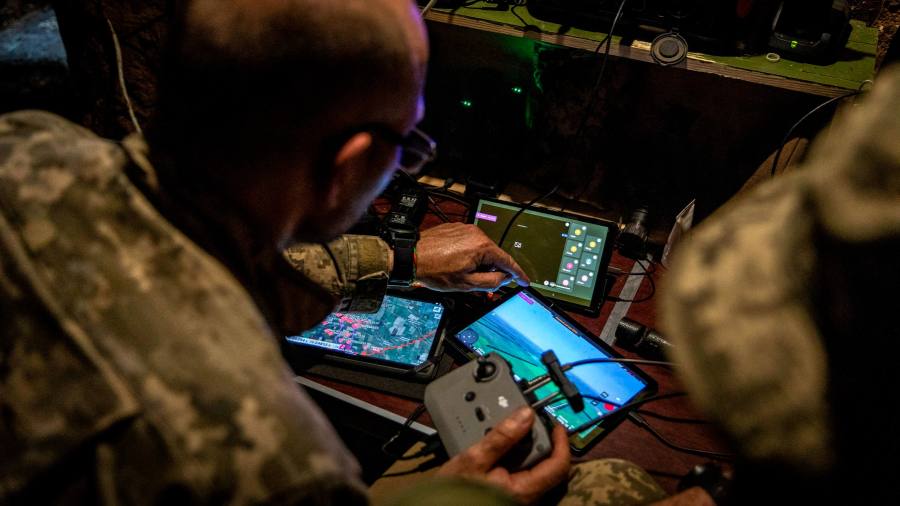Receive free Technology updates
We’ll send you a myFT Daily Digest email rounding up the latest Technology news every morning.
Maria Berlinska, one of Ukraine’s drone warriors, articulates in three sentences what regiments of social scientists struggle to explain in reams of research papers. “We have to be innovative, man. You know why? Because we would like to survive,” says Berlinska, who heads her country’s Victory Drones project, in a recent FT Film on Ukraine’s tech sector.
Existential threats tend to clarify national priorities. Bluntly put, Ukraine has had to innovate or die.
Berlinska is one of a remarkable cohort of Ukrainians who are using innovative technology to help resist Russia’s brutal invasion that began in February 2022. Since then, Ukraine has received a lot of military hardware from Nato countries. But, still outgunned and outmanned, it has had urgently to develop its own defence capabilities, often by adapting civilian technologies to military ends. It is now extensively using drones for surveillance, reconnaissance and precision attacks.
In January, Ukraine’s defence ministry announced it would spend $550mn on drone technology this year, signing deals with 16 Ukrainian manufacturers. Drones have since struck the Kremlin in the heart of Moscow — although Kyiv denies involvement — and last week hit a Russian warship near its naval base in Novorossiysk. The widespread use of drones is changing the nature of warfare and Ukraine is at the forefront of this military revolution.
One of the enduring mysteries of economics is why some countries succeed at innovating while others fall behind. The policy playbook is pretty clear: educate the workforce, invest in research and development, support strong universities, protect intellectual patents and promote free trade. But even those that follow this playbook can have strikingly different results. Nations can also change over time — for better or worse.
Before the war, Ukraine had a small but vibrant tech sector, particularly in cyber security. Since Russia’s annexation of Crimea in 2014, Ukraine has been under constant attack from Russian hackers and its software engineers quickly learnt how to defend the digital infrastructure. But last year’s invasion has massively boosted Ukraine’s adoption of technology, particularly in secure communications, data processing and drones. Its exports of IT services rose from $5bn in 2020 to £7.3bn last year.
Some predict that after the war Ukraine will emerge as one of the world’s most dynamic technology centres. “Ukraine is Israel but size XXL,” Oleg Rogynskyy, the Dnipro-born founder of the software company People.ai, tells me.
It is hardly a secret that war can be a stimulus for innovation. Anyone who has seen the film Oppenheimer will appreciate the enormous resources the US government threw at developing the first atomic bomb. The US Department of Defense helped build Silicon Valley during the cold war era. The Pentagon was one of the earliest and most voracious customers of silicon chips, which it used to guide its missiles.
The space race between the Soviet Union and the US was also a byproduct of superpower rivalry. Several of today’s global innovation hotspots, including Israel, Taiwan, South Korea and Estonia, lie on geopolitical faultlines.
But long periods of peace often reduce the impetus to innovate. One theory as to how stability can sap innovation was advanced by the late Mancur Olson in his classic 1982 book The Rise and Decline of Nations. He argued that over time special interest groups, often hostile to new technology, open competition and free trade, would accumulate power and produce institutional sclerosis in stable democracies. Politicians would then favour wealth distribution over technological innovation, which often brings social disruption.
Developing Olson’s analysis, Mark Zachary Taylor has more recently proposed the theory of “creative insecurity” in his book The Politics of Innovation. This suggests that innovation in science and technology often accelerates when a nation’s concerns about external threats suppresses domestic rivalries.
Ukraine is a classic case. Before the war, it was racked by divisive oligarchic politics and scored poorly in Transparency International’s Corruption Perceptions Index. “Ukraine has had a fundamental choice to make: to address internal corruption and rivalries and share the costs and risks of innovation or to become a failed state and get taken over by Russia,” Taylor tells me.
No one would wish the devastation of war on anyone for the sake of innovation. However, Taylor raises the intriguing question whether societies can benefit from the positive dynamics of creative insecurity without the threat of military catastrophe. Can that sense of innovative urgency be mobilised to confront non-human threats, such as disease or climate change? The rapid development of Covid vaccines provides some hope. The failure to contain global warming highlights the doubts.
According to Taylor, an emerging school of political science suggests the stark differences between the world views of conservatives and progressives in the US is as much psychological as ideological, especially over non-human threats. “Conservatives tend to see threats and opportunities in different ways than progressives do,” he says.
Both may agree that China is a geopolitical rival to the US. But they are unlikely ever to share the view that climate change is humanity’s most deadly enemy.
Read the full article here



